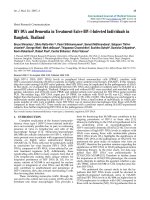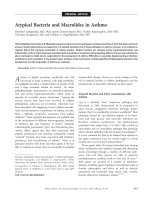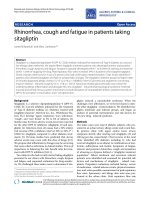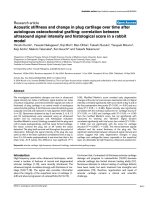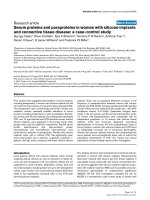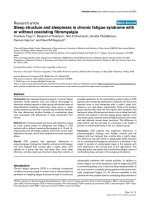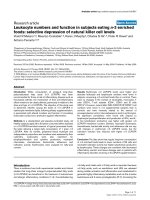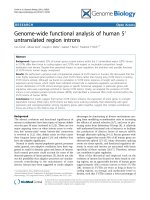Báo cáo y học: " Comparative efficacy and acceptability of methylphenidate and atomoxetine in treatment of attention deficit hyperactivity disorder in children and adolescents: a meta-analysis" pdf
Bạn đang xem bản rút gọn của tài liệu. Xem và tải ngay bản đầy đủ của tài liệu tại đây (470.68 KB, 8 trang )
RESEARCH ARTICLE Open Access
Comparative efficacy and acceptability of
methylphenidate and atomoxetine in treatment
of attention deficit hyperactivity disorder in
children and adolescents: a meta-analysis
Raveen Hanwella, Madhri Senanayake and Varuni de Silva
*
Abstract
Background: Psychostimulants and non stimulants are effective in the treatment of ADHD. Efficacy of both
methylphenidate and atomoxetine has been established in placebo controlled trials. Direct comparison of efficacy
is now possible due to availability of results from several head-to-head trials of these two medications.
Methods: All published, randomized, open label or double blind trials, comparing efficacy of methylphenidate with
atomoxetine, in treatment of ADHD in children, diagnosed using DSM-IV™ criteria were included. The outcome studied
was ADHDRS-IVParent:Inv score. The standardized mean difference (SMD) was used as a measure of effect size.
Results: Nine randomized trials comparing methylphenidate and atomoxetine, with a total of 2762 participants
were in cluded. Meta-analysis did not find a significant difference in efficacy between methylphenidate and
atomoxetine (SMD = 0.09, 95% CI -0.08-0.26) (Z = 1.06, p = 0.29). Synthesis of data from eight trials found no
significant difference in response rates (RR = 0.93 95% CI 0.76-1.14, p = 0.49). Sub group analysis showed a
significant standardized mean difference favouring OROS methylphenidate (SMD = 0.32, 95% CI 0.12-0.53 (Z = 3.05,
p < 0.002). Immediate release methylphenidate was not superior to atom oxetine (SMD = -0.04, 95% CI -0.19-0.12)
(Z = 0.46, p = 0.64). Excluding open label trials did not significantly alter the effect size (SMD = 0.08, 95% CI -0.04-
0.21) (Z = 1.27, p = 0.20). All-cause discontinuation was used as a measure of acceptability. There was no
significant difference in all cause discontinuation between atomoxetine and methylphenidate (RR 1.22, 95% CI 0.87-
1.71). There was significant heterogeneity among the studies (p = 0.002, I
2
= 67%). Subgroup analysis
demonstrated the heterogeneity to be due to the open label trials (p = 0.001, I
2
= 81%).
Conclusions: In general atomoxetine and methylphenidate have comparable efficacy and equal acceptability in
treatment of ADHD in children and adolescents. However OROS methylphenidate is more effective than
atomoxetine and may be considered as first line treatment in treatment of ADHD in children and adolescents.
Background
Pathophysiology of ADHD is multifactorial and its cau-
sal mechanisms have not precisely been established.
However structural and functional imaging studies sug-
gest that dysfunction of cingulate,frontal,andparietal
cortical regions and imbalances in the dopaminergic and
noradrenergic systems, co ntribute to t he pathophysiol-
ogy of ADHD [1,2].
It is characterized by inattention, hyperactivity and
impulsivity. Estimates of worldwide prevalence of
ADHD among school aged children vary from 2.4-19.8%
[3-5]. Children with ADHD commonly exhibit disruptive
behaviour in the classroom and underachieve academi-
cally. ADHD is associated with co-morb idities such as
learning disorders, tics, anxiety, oppositional defiant dis-
order and conduct disorder [6]. In the long term, antiso-
cial behavior, substance abuse, and a variety of problems
related to conduct and learning can occur [7].
* Correspondence:
Department of Psychological Medicine, Faculty of Medicine, University of
Colombo, Sri Lanka
Hanwella et al. BMC Psychiatry 2011, 11:176
/>© 2011 Hanwella et al; licensee BioMed Cent ral Ltd. This is an Open Access arti cle distributed under the terms of the Creative
Commons Attribution License (http://cr eativecommons.org/licenses/by/2.0), which permits unrestricted use, distribution, and
reproduction in any medium, provided the original work is properly cited.
Both psychosocial interventions and pharmacological
treatment are effective in reducing ADHD symptom fre-
quency and severity [3]. Methylphenidate, a psychosti-
mulant, is available in short and extended release forms.
In addition methylphenidate transdermal system pro-
vides consistent delivery o f medication over the course
of the da y, acting for approximately 12 hours. Other sti-
mulants effectiv e in treatment of ADHD are dexamphe-
tamine and mixed amphetamine salts. Stimulant
medication reduces over activity, impulsivity, inattention
and improves problematic behaviours [8,9].
Several n on-stimulant medications have been used in
the treatment of ADHD. The non-stimulant atomoxe-
tine was introduced in the United States in 2002. It is a
selective norepinephrine reuptake inhibitor. Double
blind studies have established its efficacy in treatment of
ADHD [10]. Tricyclic antidepressants and bupropion
are other non-stimulants which are effective in treat-
ment of ADHD [11].
Efficacy of both methylphenidate and atomoxetine has
been established in placebo controlled trials [12-15].
Direct comparison of efficacy is now possible due to
availability of results from several head-to- hea d trials of
these two medications. Individual studies may lack ade-
quate power to demonstrate a difference in treatment
effect between the two medications. Meta-analysis
allows pooling of data from all head to head trials and
the findings will help clinicians in selecting medications
for treatment of ADHD.
Methods
Study eligibility
We included all published randomized, open label and
double blind trials published in any language which
comp ared efficacy of methylphenidate with atomoxetine
in the tr eatment of AD HD diagnosed using the Diag-
nostic and Statistical Manual of Mental Disorders,
Fourth Edition (DSM-IV™) criteria, in children and
adolescents [16].
Search strategy
A study protocol detailing sources of data, search strat-
egy, outcome measures, study selection criteria and sta-
tistical analysis was developed.
Studies were identified by searches for the period Jan-
uary 1995-December 2010. We searched PubMed, the
Cochrane Central Register of Controlled Trials and the
Cochrane Database of Systematic reviews. We also
looked at the references of selected full text articles.
Search terms used were atomoxetine, tomoxetine,
methylph enidate, attention deficit/hyperactivity disorder,
ADHD, psychostimulants, stimulants, randomized con-
trolled trial, trial, study.
Study selection
A trial flow summary is given in Figure 1. Titles and
abstracts of selected studies were reviewed indepen-
dently by two authors. Articles were selected for full
text review if incl usion criteria were met. Disagreement
about selection of a rticles was resolved by discussion
between two authors and if agreement could not be
reached, by the third author.
Methodological quality of the included studies was
evaluated using the Detsky Quality Scale for Rando-
mized Trials [17]. This scale g ives a score ranging from
0-20 for positive trials and 0-21 for negative trials. The
scale evaluates randomization, description of outcome
measures, i nclusion and exclusion criteria and descrip-
tion of therapy and statistics. Since all selected studies
scored more than 12 on the Detsky quality scale, all
were included in the meta-analysis.
Data extraction
Data was extracted independently by two authors using
a predesigned data extraction form. Title, yea r of publi-
cation, total number of participants, age of participants,
design of study (parallel vs. crossover), blinding, name
and dose of drug, number who dropped out and out-
come measures were recorded. When data on standard
deviations were missing, study authors were contacted
to provide missing data [18] or it was calculated using
the standard error of subgroups o r confidence intervals
[19-21]. Data was double entered by two authors.
Statistical analysis
Outcomes studied w ere ADHDRS-IV Parent: Inv and
Turgay DSM-IV-Based Child and A dolescent Behavior
Disorders Screening and Rating Scale (T-DSM-IV-S)
scores [22,23]. The standardiz ed mean difference (SMD)
was used as a measure of effect size. The ADHDRS-IV-
Parent: Inv consists of 18 items corresponding to the 18
ADHD symptoms listed in the DSM-IV. Each item is
rated on a scale from 0 = ‘ never/ rarely’ to 3 = ‘ very
often.’ The total score ranges from 0 to 54. The T-
DSM-IV-S is based on the DSM-IV diagnostic criteria
and assesses hyperactivity-impu lsivity (9 item s), inatten-
tion (9 items), opposition-defiance (8 items), and con-
duct disorder (15 items).
The relative risk of response was calculated. All cause
discontinuation was used as a measure of acceptability.
For these dichotomous outcomes, risk ratio (RR) was
computed using the Mantel-Haenszel method. Data was
analyzed using Review Man (RevMan) version 5.0 for
Windows [24].
Meta-analysis was carried out using the random-
effects model of DerSimonian and Laird [25]. The pre-
sence of heterogeneity between studies was tested using
Hanwella et al. BMC Psychiatry 2011, 11:176
/>Page 2 of 8
the Cochran’s Q. The magnitude of heterogeneity was
determined using the I
2
statistic.
There are reports that osmotically released methylphe-
nidate is more effective than immediate release methyl-
phenidate (IR MPH) [26]. Sub group analysis was
conducted to examine whether treatment effect sizes
varied between the f ormulations of methylphenidate.
Because of the difference in methodological quality
between double blind studies and open label trials, a
sensitivity analysis was carried out excluding open label
trials. One study used a cross-over design. As study
results may be affected by a carry-over effect, we also
conducted a sensitivity analysis excluding the cross-over
trial.
Results
Study characteristics
Nine randomized trials comparing methylphenidate
and atomoxetine in the treatment of ADHD in chil-
dren and adolescents were identified (total participants
2762) [18-21,27-30]. The publication by Spencer et al.
reported on two trials B4Z-MC-HFBD and B4Z-MC-
HFBK [21]. Table 1 summarizes the characteristics of
patients. Trial participants were aged 6-16 years. There
were more male than female participants (77.6%) and
majority was Caucasian (67%). Of the participants
47.4% had been previously treated with stimulants.
Comorbid oppositional defiant disorder was diagnosed
in 36%.
Figure 1 Study flow summary.
Hanwella et al. BMC Psychiatry 2011, 11:176
/>Page 3 of 8
Table 2 summarizes the study characteristics. Five
trials compared immediate release methylphenidate (IR
MPH) with atomoxetine [18,21,27,29]. Three trials com-
pared atomoxetine and osmotically released methylphe-
nidate (OROS MPH) which is an extended release
formulation [19,28,30]. One t rial used both short acting
methylphenidate and OROS MPH [ 20]. Eight trials
employed a parallel design [19-21,27-30]. One trial
employed a cross-over design [18]. In another trial
which employed a cross-over design, only da ta from the
first six weeks of treatment (parallel design) was
included in the meta-analysis [28]. In the study which
compared atomoxetine with standard treatment, only
data for patients who received methylphenidate as their
initial treatment was included in the analysis [20].
The final mean daily atomoxetine dose used in the trials
ranged from 1.28 mg/kg-1.56 mg/kg. However one study
used a smaller mean dose for patients who were identified
as atomoxetine slow metabolizers [27]. Final mean daily
dose for immediate release methylphenidate ranged from
0.8 mg/kg -1.12 mg/kg except for the study by Wang et al.
which used a final dose range of 0.2-0.6 mg/kg. Mean dose
Table 1 Summary of patient characteristics
Characteristic Atomoxetine Methylphenidate Total
Age mean (SD)
Gender n(%)
Male 1030 (79.8) 973 (75.4) 2003
(77.6)
Female 260 (20.2) 317 (25.6) 577
(22.4)
Ethnic origin
Caucasian 871 (61.8) 946 (72.7) 1817
(67.0)
Others 539 (38.2) 355 (27.3) 894
(33.0)
ADHD subtype
Hyperactive/impulsive 19 (2.3) 11 (2.0) 30
(2.2)
Inattentive 191 (23.3) 152 (28.3) 343
(25.3)
combined 609 (74.4) 374 (69.7) 983
(72.5)
Prior stimulant use- yes 544 (55.0) 528 (41.4) 1072
(47.4)
Comorbid oppositional
defiant disorder
273 (39.0) 134 (31.1) 407
(36.0)
Table 2 Study characteristics
Study Number of
participants
Blinding Design Follow-
up
Baseline severity
ADHD-RS total score
Mean daily dose-
atomoxetine and
frequency
Mean daily dose-
methylphenidate and
frequency
Yildiz
2010
n = 25 Open
label
Parallel
group
12
weeks
Parents T-DSM-IV
inattention scores
atomoxetine = 16.72
MPH = 17.72
1.28 mg/kg/day
Once a day
OROS-MPH = 1.07 mg/kg
(IR = equivalent 0.89 mg/kg)
Once a day
Newcorn
2008
n = 442 Double
blind
Parallel
group
6
weeks
Atomoxetine = 40.9
(SD 8.8)
MPH = 40.0
(SD 8.8)
1.45 mg/kg
Twice a day
OROS-MPH =
1.16 mg/kg
(IR equivalent = 0.966 mg/kg
Once a day
Prasad
2007
n = 180 Open
label
Parallel
group
10
weeks
Atomoxetine = 45.5
(SD 8.7)
MPH not stated
1.5 mg/kg
Once a daily
8 pts got twice daily
IR MPH = 0.8 mg/kg
OROS-MPH = 1.03 mg/kg
(IR equivalent = 0.858 mg/kg)
Wang
2007
n = 330 Double
blind
Parallel
group
8
weeks
Atomoxetine = 38.6
(SD 7.6)
MPH = 37.4
(SD 7.6)
Final range
0.8 mg/kg-1.8 mg/kg
Once a day
IR MPH = 17.8/mg/day
Twice a day
Kemner
2005
n = 1323 Open
label
Parallel
group
3
weeks
Atomoxetine = 38.6
(SD 8.1)
MPH = 39.
1.08 mg/kg/Once a day OROS-MPH 1.01 mg/kg/day
(IR equivalent 0.841 mg/kg)
Once a day
Sangal
2005
n = 85 Double
blind
Cross
over
7
weeks
Atomoxetine = 39.6
MPH not stated
1.56 mg/kg/day
Twice a day
IR MPH = 1.12 mg/kg
Three times a day
Kratochvil
2002
n = 228 Open
label
Parallel
group
10
weeks
Atomoxetine
= 39.4
MPH = 37.6
0.48 mg/kg*
or
1.4 mg/kg/kg**
Twice daily
Final mean dose 0.85 mg/kg
Three times a day
Spencer
2002 HFBD
n = 84 Double
blind
Parallel
group
9
weeks
Atomoxetine = 39.5 1.56 mg/kg
Twice a day
IR MPH = 1.12 mg/kg
Twice a day
Spencer
2002 HFBK
n = 79 Double
blind
Parallel
group
9
weeks
Atomoxetine = 39.5 1.56 mg/kg
Twice a day
IR MPH = 1.12 mg/kg
Twice a day
*atomoxetine slow metabolisers **atomoxetine rapid metabolisers
18 mg OROS MPH = 15 mg IR MPH
Hanwella et al. BMC Psychiatry 2011, 11:176
/>Page 4 of 8
of osmotically rel eased methylphenidate when converted
to immediate release dose equivalents ranged from 0.84
mg/ kg 0.97 mg/ kg. Atomoxetine wa s admin istered twice
daily in five studies [18,21,27,28]. IR MPH was adminis-
tered twice daily in two studies [21,29] while three studies
administered thrice daily [18,21,27]. In one study the
methylphenidate dosing schedule varied [20]. OROS MPH
was administered once daily.
Duration of trials ranged from 3-10 weeks. Baseline
severity of illness as measured by ADHD-RS scores ranged
from 38.6-45.5 for atomoxetine and 37.4-40.0 for methyl-
phenidate. One trial used Parents T-DSM-IV total to mea-
sure outcome and reported baseline severity of 44.2 (SD
7.5) for atomoxetine and 47.3 (SD 16.7) for MPH [30].
All studies except one excluded patients with tics.
Patients with a history of bipolar disorder, psychosis,
anxiety, seizures and current his tory or family history of
Tourette syndrome were also used as exclusion criteria
in several studies. Most of these are relative contraindi-
cations in clinical practice but are standard exclusion
criteria in trials.
Meta-analysis
The results for the primary outcome are summarized in
Figure 2. We used a random effects model in the meta-
analysis because the subjects and interventions in the
studies have differed in ways that would have impacted
on the results. Meta-analysis did not find a significant
difference in effic acy between methylphenidate and ato-
moxetine when standardized mean difference (SMD)
was used as a measure of effect size 0.09 (95% CI -0.08-
0.26) (Z = 1.06, p = 0.29).
Response rate
Response rates were available for eight trials. Definition
of response varied betw een trials. Five studies defined
response as a ≥40% reduction from baseline to endpoint
in the ADHDRS-IV-Parent:Inv [ 20,21,28,29]. One study
defined response as a ≥25% reduction o n the same scale
[18]. For another study ≥50%reductioninscoreswas
used as the definition of response [19]. One trial defined
response as T-DSM-IV-S less than 40% of baseline
scores [30]. There was no significant difference in
response rates between the two medications (RR = 0.93
95% CI 0.76-1.14, p = 0.49).
Sub group analysis
Sub group analysis showed a significant standardized
mean difference favouring OROS methylphenidate 0.32
(95% CI 0.12-0.53 (Z = 3 .05, p < 0.002). Immediate
release methylphenidate was not superior to atomoxe-
tine SMD -0.04 (95% CI -0.19-0.12) (Z = 0.46, p =
0.64).
Sensitivity analysis
Excluding open label trials did not significantly alter the
pooled standardized mean difference 0.08 (95% CI
-0.04-0.21) (Z = 1.27, p = 0.20). Excluding the cross
over trial too did not change the results significantly
0.11 (95% CI -0.07-0.29) (Z = 1.23 p = 0.22).
Acceptability
Data from seven studies was available for assessment of
all-cause discontinuation. There was no significant dif-
ference in all cause discontinuation between
Figure 2 Standardized mean difference in ADHDRS-IV scores for methylphenidate and atomoxetine.
Hanwella et al. BMC Psychiatry 2011, 11:176
/>Page 5 of 8
atomoxetine and methylphenidate (RR 1.22, 95% CI
0.87-1.71, p = 0.25).
Heterogeneity
Heterogeneity is a measure of variation of effect size. I
2
is an estimation of the propo rtion of the observed var-
iance reflecting real differences among studies. There
was significant heterogeneity among the studies (p =
0.002, I
2
= 67%). Subgroup analysis found that the het-
erogeneity was due to the open label trials (p = 0.001, I
2
= 81%). There was no significant heterogeneity among
double blind trials (p = 0.48 I
2
= 0%).
Publication bias
Publication bias occurs if studies with small effect size
or those showing no significant difference between the
two medications ar e not published. However we were
unable to carryout tests for funnel plot asymmetry due
to the small number of studies.
Discussion
This meta-analysis synthesized data from all trials
comparing atomoxetine and methylphenidate in treat-
ment of ADHD in children and adolescents. Placebo
controlled trials have established that both methylphe-
nidate and atomoxetine are effective in treatment of
ADHD in children and adolescents [15,31,32]. This
meta-analysis shows that in children and adolescents
with ADHD, although the effect size favours methyl-
phenidate the difference was not statistically signifi-
cant. Subgroup analysis shows a significant
standardized mean difference favouring OROS methyl-
phenidate over atomoxetine. However immediate
release methylphenidate was not superior to atomoxe-
tine. There was no difference in acceptability as mea-
sured by all cause drop-out rate for methylphenidate
and ato moxetine.
Two previous m eta-analysis comparing a tomoxetine
and methylphenidate have included a smaller number of
studies. Meta- analysis by Gibson et al. included five
head to head trials comparing psychostimulants and ato-
moxetine [33,34]. The most recent met a-analysis
excluded the largest studies by Kemner et al. as the
study duration was only three wee ks [34]. Our findings
support those by Gibson et al. that OROS methylpheni -
date showed superior efficacy but there was no signifi-
cant difference between atomoxetine and immediate
release methylphenidate [33].
There is some evidence from randomized open label
trials that OROS methylphenidate was superior to the
immediate release form in treatment of ADHD [26,35].
However other studies have found no significant differ-
ence in efficacy between immediate release MPH three
times a day and once daily OROS MPH [36-38].
Several methodological factors may have influenced
the outcome of individual trials. The relatively lower
efficacy of IR MPH may be explained by the dosing
schedules. Only two studies administered an evening
dose of IR MPH [16,25]. Symptom severity was assessed
using the parent version of ADHDRS-IV and parents
are likely to evaluate behaviours occurring outside
school hours. The effect of IR MPH may wear off later
in the day and this could account for the lower efficacy
when IR MPH was administered only once or twice
daily. Our meta-analysis found that the standardized
mean difference in ADHD scores between atomoxetine
and methy lphenidate using parent ratings were relatively
small and the difference may have been much larger if
studies had used teacher ratings, becau se teacher ra tings
evaluate behavior during school hours. However only
one study included in this meta-analysis used teacher
ratings [30]. A meta-analysis by Cheng et al. showed
that the effect size of atomoxetine using parent ratings
was 0.34, about half of the effect size in teacher rating
of 0.62 [39]. The meta-analysis reported a much smaller
effect size f or atomoxetine than that reported for MPH
in studies using teacher ratings. Therefore the advantage
of methylphenidate over atomoxetine appears larger in
school than at home.
In contrast long acting OROS-methylphenida te which
provides coverage in the late afternoon and evening may
have an advantage over the immediate release form. The
immediate release MPH equivalent does of OROS MPH
used in the trials was 0.84 mg/kg-0.97 mg/kg. Therefore
dose alone cannot account for the superiority of OROS
methylphenidate.
Four trials used high doses of atomoxetine (> 1.4 mg/
kg) administered twice daily [18,21,28]. The outcome in
three of these trials favoured atomoxetine suggesting
that higher doses of atomoxetine administered twice
daily may be more effective.
Some design features would have been disadvanta-
geous to atomoxetine. The trial with the largest number
of participants was of short duration of three weeks
[19]. This time period may not be adequate as optimal
efficacy of atomoxetine requires 4-6 weeks of treatment
[40]. Two trials excluded participants with previous
poor response to methylphenidate, a design feature
which would have favoured methy lphenidate [27,28].
Although A DHD has high rates of comorbidity, subjects
with tics, family history of Tourette syndrome and anxi-
ety were excluded in most studies because methylpheni-
date use is contraindicated in these conditions. This
may have exclude participants who are poor methylphe-
nidate responders. Atomoxetine may not be as effective
in pat ients with comorb id oppositional defiant disorder
(ODD) [41]. Of all the trial participants 36% were diag-
nosed as having comorbid ODD.
Hanwella et al. BMC Psychiatry 2011, 11:176
/>Page 6 of 8
Atomoxetine may be recommended for those with
comorbid conditions where methylphenidate is contrain-
dicated. Methylphenidate is contraindic ated in indivi-
duals with structural cardiac abnormalities, arrhythmias,
psychosis and suicidal ideation. However reports of sui-
cidal ideation with atomoxetine and hepatic disorders
have prompted warnings about t he use of atomoxetine
in these conditions [42]. In cardiovascular disease too,
atomoxetine must be used with caution. There are con-
cerns about the use of stimulants in children with
comorbid seizure disorder and tics. There is evidence
that in individuals with well controlled epilepsy, stimu-
lants can be used safely and atomoxetine may also be
associated with increased risk of seizures [43]. A recent
review suggests that stimulants may not worsen tics in
most with tic disorders [44].
The findings of this meta-analysis have to be inter-
preted cautiously b ecause of several limitations. Inter-
pretation of our findings is hampered by the substantial
heterogeneity across studies. Sensitivity analysis showed
the source of heterogeneity is the open label studies.
Open label studies introduce bias as patient and investi-
gator expectations can influence outcome. Beca use the
number of studies within each subgroup is small there
may not be adequate power to detect a difference
between the two treatments. We did not include unpub-
lished data from conference abstracts, dissertations and
unpublished pharmaceutical c ompany data, therefore
publication bias is a distinct possibility. Tests for funnel
plot asymmetry were not done as the Cochrane hand-
book for systematic reviews recommends that tests f or
funnel plot asymmetry should be used only when there
are at least 10 studies included in the meta-analysis [45].
Since many of the trials ex cluded subpopulations with
comorbid conditions the results of the meta-analysis
cannot be generalized to these subpopulations. Seven
studies were funded by Eli Lill y and Company manufac-
turers of atomoxetine and one study was sponsored b y
McNeil Consumer and Specialty Pharmaceuticals [19].
In addition several design features would have influ-
enced the outcome of trials including non- inclusion of
teacher rating scales wh ich would have been a disadvan-
tage for methylphenidate.
The findings of the meta-ana lysis have implications
for clinical practic e. The results from the meta-ana ly-
sis show that in general atomoxetine and methylphe-
nidate have comparable efficacy and equal
acceptability in treatment of ADHD in children and
adolescents. It also suggests that OROS methylpheni-
date is more effective and may be considered as first
line treatment in treatment of ADHD in children and
adolescents. Atomoxetine may be used in those with
poor response to methylphenidate or where stimulant
abuse is a cause for concern. Use of higher doses of
atomoxetine administered twice daily may result in
better outcome.
Conclusions
In general atomoxetine and methyl phenidate have com-
parable efficacy and equal acceptability in treatment of
ADHD in children and adolescents. H owever OROS
methylphenidate is more effective than atomoxetine and
may be considered as first line treatment in treatment
of ADHD in children and adolescents.
Authors’ contributions
All authors contributed to designing the study, data collection and analyzing
the data. RH and VdeS drafted the manuscript. All authors read and
approved the final manuscript.
Competing interests
RH and VdeS have received travel grants to attend academic meetings from
Sun Pharma India. MS has no conflict of interest.
Received: 9 April 2011 Accepted: 10 November 2011
Published: 10 November 2011
References
1. Biederman J: Attention-deficit/hyperactivity disorder: A selective
overview. Biol Psychiatry 2005, 57:1215-1220.
2. Del Campo N, Chamberlain SR, Sahakian BJ, Robbins TW: The Roles of
Dopamine and Noradrenaline in the Pathophysiology and Treatment of
Attention-Deficit/Hyperactivity Disorder. Biol Psychiatry 2011, 69(12):
e145-57.
3. American Association of Pediatrics: Clinical practice guideline: diagnosis
and evaluation of the child with attention-deficit/hyperactivity disorder.
American Academy of Pediatrics. Pediatrics 2000, 105(5):1158-1170.
4. Centers for Disease Control and Prevention: Mental health in the United
States. Prevalence of diagnosis and medication treatment for attention-
deficit/hyperactivity disorder–United States, 2003. MMWR Morb Mortal
Wkly Rep 2005, 54(34):842-847.
5. Faraone SV, Sergeant J, Gillberg C, Biederman J: The worldwide prevalence
of ADHD: is it an American condition? World Psychiatry 2003, 2(2):104-113.
6. MTA Cooperative Group: A 14-month randomized clinical trial of
treatment strategies for attention-deficit/hyperactivity disorder. The MTA
Cooperative Group. Multimodal Treatment Study of Children with
ADHD. Arch Gen Psychiatry 1999, 56(12):1073-1086.
7. Newcorn JH: Advances in the Management of Attention-Deficit/
Hyperactivity Disorder: An Evidence-Based Update. Managed Care
Consultant 2007, 6(2).
8. Kavale K: The efficacy of stimulant drug treatment for hyperactivity: a
meta-analysis. J Learn Disabil 1982, 15(5):280-289.
9. Thurber S, Walker CE: Medication and hyperactivity: a meta-analysis. J Gen
Psychol 1983, 108(1st Half):79-86.
10. Hammerness P, McCarthy K, Mancuso E, Gendron C, Geller D: Atomoxetine
for the treatment of attention-deficit/hyperactivity disorder in children
and adolescents: a review. Neuropsychiatr Dis Treat 2009, 5:215-226.
11. Conners CK, Casat CD, Gualtieri CT, Weller E, Reader M, Reiss A, Weller RA,
Khayrallah M, Ascher J: Bupropion hydrochloride in attention deficit
disorder with hyperactivity. J Am Acad Child Adolesc Psychiatry 1996,
35(10):1314-1321.
12. Faraone SV, Spencer T, Aleardi M, Pagano C, Biederman J: Meta-analysis of
the efficacy of methylphenidate for treating adult attention-deficit/
hyperactivity disorder. J Clin Psychopharmacol 2004, 24(1):24-29.
13. Faraone SV, Biederman J, Spencer TJ, Aleardi M: Comparing the efficacy of
medications for ADHD using meta-analysis. MedGenMed 2006, 8(4):4.
14. Kratochvil CJ, Milton DR, Vaughan BS, Greenhill LL:
Acute atomoxetine
treatment
of younger and older children with ADHD: a meta-analysis of
tolerability and efficacy. Child Adolesc Psychiatry Ment Health 2008, 2(1):25.
15. Schachter HM, Pham B, King J, Langford S, Moher D: How efficacious and
safe is short-acting methylphenidate for the treatment of attention-
Hanwella et al. BMC Psychiatry 2011, 11:176
/>Page 7 of 8
deficit disorder in children and adolescents? A meta-analysis. CMAJ 2001,
165(11):1475-1488.
16. American Psychiatric Association: Diagnostic and statistical manual of mental
disorders. 4 edition. American Psychiatric Association, Washington, DC; 2000.
17. Detsky AS, Naylor CD, O’Rourke K, McGeer AJ, L’Abbe KA: Incorporating
variations in the quality of individual randomized trials into meta-
analysis. J Clin Epidemiol 1992, 45(3):255-265.
18. Sangal RB, Owens J, Allen AJ, Sutton V, Schuh K, Kelsey D: Effects of
atomoxetine and methylphenidate on sleep in children with ADHD.
Sleep 2006, 29(12):1573-1585.
19. Kemner JE, Starr HL, Ciccone PE, Hooper-Wood CG, Crockett RS: Outcomes
of OROS methylphenidate compared with atomoxetine in children with
ADHD: a multicenter, randomized prospective study. Adv Ther 2005,
22(5):498-512.
20. Prasad S, Harpin V, Poole L, Zeitlin H, Jamdar S, Puvanendran K: A multi-
centre, randomised, open-label study of atomoxetine compared with
standard current therapy in UK children and adolescents with attention-
deficit/hyperactivity disorder (ADHD). Curr Med Res Opin 2007,
23(2):379-394.
21. Spencer T, Heiligenstein JH, Biederman J, Faries DE, Kratochvil CJ,
Conners CK, Potter WZ: Results from 2 proof-of-concept, placebo-
controlled studies of atomoxetine in children with attention-deficit/
hyperactivity disorder. J Clin Psychiatry 2002, 63(12):1140-1147.
22. DuPaul GJ, Power TJ, Anastopoulos AD, Reid R: ADHD rating scale-IV
checklists, norms, and clinical interpretation New York: The Guilford Press;
1998.
23. Turgay: Disruptive Behavior Disorders Child and Adolescent Screening and
Rating Scales for Children, Adolescents, Parents, and Teachers West Blomfield:
Integrative Therapy Institute Publication; 1994.
24. The Nordic Cochrane Centre: Review Manager (RevMan)
[ComputerProgram] Version 5.0. Copenhagen: The Cochrane
Collaboration;, Version 5.0 2008.
25. DerSimonian R, Laird N: Meta-analysis in clinical trials. Control Clin Trials
1986, 7(3):177-188.
26. Steele M, Weiss M, Swanson J, Wang J, Prinzo RS, Binder CE: A randomized,
controlled effectiveness trial of OROS-methylphenidate compared to
usual care with immediate-release methylphenidate in attention deficit-
hyperactivity disorder. Can J Clin Pharmacol 2006, 13(1):e50-62.
27. Kratochvil CJ, Heiligenstein JH, Dittmann R, Spencer TJ, Biederman J,
Wernicke J, Newcorn JH, Casat C, Milton D, Michelson D: Atomoxetine and
methylphenidate treatment in children with ADHD: a prospective,
randomized, open-label trial. J Am Acad Child Adolesc Psychiatry 2002,
41(7):776-784.
28. Newcorn JH, Kratochvil CJ, Allen AJ, Casat CD, Ruff DD, Moore RJ,
Michelson D: Atomoxetine and osmotically released methylphenidate for
the treatment of attention deficit hyperactivity disorder: acute
comparison and differential response. Am J Psychiatry 2008,
165(6):721-730.
29. Wang Y, Zheng Y, Du Y, Song DH, Shin YJ, Cho SC, Kim BN, Ahn DH,
Marquez-Caraveo ME, Gao H, et al: Atomoxetine versus methylphenidate
in paediatric outpatients with attention deficit hyperactivity disorder: a
randomized, double-blind comparison trial. Aust N Z J Psychiatry 2007,
41(3):222-230.
30. Yildiz O, Sismanlar SG, Memik NC, Karakaya I, Agaoglu B: Atomoxetine and
Methylphenidate Treatment in Children with ADHD: The Efficacy,
Tolerability and Effects on Executive Functions. Child Psychiatry Hum Dev
2010.
31. Cheng JY, Chen RY, Ko JS, Ng EM: Efficacy and safety of atomoxetine for
attention-deficit/hyperactivity disorder in children and adolescents-
meta-analysis and meta-regression analysis. Psychopharmacology (Berl)
2007, 194(2):197-209.
32. Kratochvil CJ, Wilens TE, Greenhill LL, Gao H, Baker KD, Feldman PD,
Gelowitz DL: Effects of long-term atomoxetine treatment for young
children with attention-deficit/hyperactivity disorder. J Am Acad Child
Adolesc Psychiatry 2006, 45(8):919-927.
33. Gibson AP, Bettinger TL, Patel NC, Crismon ML: Atomoxetine versus
stimulants for treatment of attention deficit/hyperactivity disorder. Ann
Pharmacother 2006, 40(6):1134-1142.
34. Hazell PL, Kohn MR, Dickson R, Walton RJ, Granger RE, van Wyk GW: Core
ADHD Symptom Improvement With Atomoxetine Versus
Methylphenidate: A Direct Comparison Meta-Analysis. J Atten Disord
2010.
35. Remschmidt H, Hoare P, Ettrich C, Rothenberger A, Santosh P, Schmidt M,
Spender Q, Tamhne R, Thompson M, Tinline C, et al: Symptom control in
children and adolescents with attention-deficit/hyperactivity disorder on
switching from immediate-release MPH to OROS MPH Results of a 3-
week open-label study. Eur Child Adolesc Psychiatry 2005, 14(6):297-304.
36. Pelham WE, Gnagy EM, Burrows-Maclean L, Williams A, Fabiano GA,
Morrisey SM, Chronis AM, Forehand GL, Nguyen CA, Hoffman MT, et al:
Once-a-day Concerta methylphenidate versus three-times-daily
methylphenidate in laboratory and natural settings. Pediatrics 2001,
107(6):E105.
37. Wolraich ML, Greenhill LL, Pelham W, Swanson J, Wilens T, Palumbo D,
Atkins M, McBurnett K, Bukstein O, August G: Randomized, controlled trial
of oros methylphenidate once a day in children with attention-deficit/
hyperactivity disorder. Pediatrics 2001, 108(4):883-892.
38. Favreau A, Deseille-Turlotte G, Brault F, Giraudeau B, Krier C, Barthez MA,
Castelnau P: [Benefit of the extended-release methylphenidate
formulations: a comparative study in childhood]. Arch Pediatr 2006,
13(5):442-448.
39. Cheng JY, Chen RY, Ko JS, Ng EM: Efficacy and safety of atomoxetine for
attention-deficit/hyperactivity disorder in children and adolescents-
meta-analysis and meta-regression analysis. Psychopharmacology (Berl)
2007, 194(2):197-209.
40. Michelson D, Allen AJ, Busner J, Casat C, Dunn D, Kratochvil C, Newcorn J,
Sallee FR, Sangal RB, Saylor K, et al: Once-daily atomoxetine treatment for
children and adolescents with attention deficit hyperactivity disorder: a
randomized, placebo-controlled study. Am J Psychiatry 2002,
159(11):1896-1901.
41. Bangs ME, Hazell P, Danckaerts M, Hoare P, Coghill DR, Wehmeier PM,
Williams DW, Moore RJ, Levine L: Atomoxetine for the treatment of
attention-deficit/hyperactivity disorder and oppositional defiant disorder.
Pediatrics 2008, 121(2)
:e314-320.
42. Bangs ME, Tauscher-Wisniewski S, Polzer J, Zhang S, Acharya N, Desaiah D,
Trzepacz PT, Allen AJ: Meta-analysis of suicide-related behavior events in
patients treated with atomoxetine. J Am Acad Child Adolesc Psychiatry
2008, 47(2):209-18.
43. Graham J, Coghill D: Adverse Effects of Pharmacotherapies for Attention-
Deficit Hyperactivity Disorder Epidemiology, Prevention and
Management. CNS Drugs 2008, 22(3):213-237.
44. Pringsheim T, Steeves T: Pharmacological treatment for Attention Deficit
Hyperactivity Disorder (ADHD) in children with comorbid tic disorders.
Cochrane Database Syst Rev 2011, 13(4):CD007990.
45. Higgins JPT, Green S, Cochrane Collaboration: Cochrane handbook for
systematic reviews of interventions Chichester, England; Hoboken, NJ: Wiley-
Blackwell; 2008.
Pre-publication history
The pre-publication history for this paper can be accessed here:
/>doi:10.1186/1471-244X-11-176
Cite this article as: Hanwella et al.: Comparative efficacy and
acceptability of methylphenidate and atomoxetine in treatment of
attention deficit hyperactivity disorder in children and adolescents: a
meta-analysis. BMC Psychiatry 2011 11:176.
Hanwella et al. BMC Psychiatry 2011, 11:176
/>Page 8 of 8

